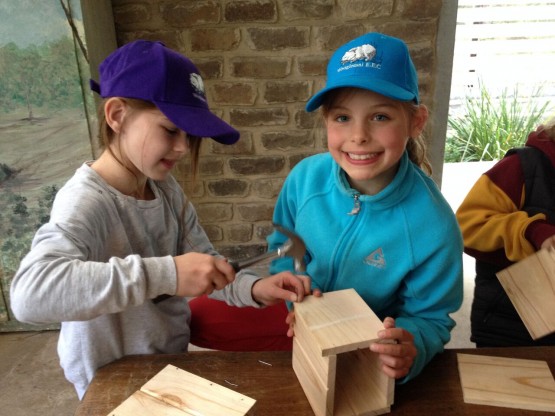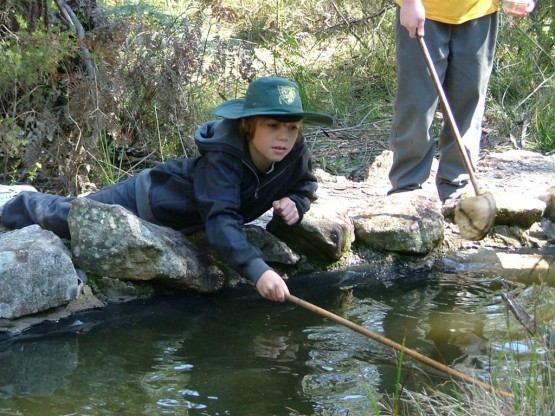Day Visit Programs
Please select the Stage tab below to view the Day Visit Program details for that Stage.
Science
Aussie Bush Safari – from “Living World” Units, Australian Curriculum
Click here for full details of this program.
Students will be involved in variety of hands-on, fun and engaging activities undertaken in the natural bushland around Wooglemai. They will participate in a ‘sensory walk’ in the beautiful Nattai National Park discovering some of the important parts of the forest and what makes it so special. Students will also explore our pond using dip-nets, find evidence of animals in the bush, examine features of some Australian animals (using a range of taxidermy animals) to learn about what plants and animals need to survive.
Creative Arts
Patterns in Nature
Click here for program details
Utilising our easy bushwalks and serene lookouts, this integrated Visual Arts and STEM program encourages students to develop their critical and creative thinking skills. As they sculpt, photograph and print, students learn about the qualities and inhabitants of the living world. Students will leave with two beautiful artworks ready for display and a love for the natural environment!
Cross curricular
"Spring into sustainability"
Students will explore the local natural area and look at the sustainable lifestyle and practices of the traditional Aboriginal custodians. They will explore the effects of our increasing population and our consumer based lifestyle on the health of the planet. Students will be challenged to look at their own lifestyle and consider it's impact on our planet. They will engage in hands on activities like cooking using solar ovens and generating electricity using a wind turbine of their own design.
A wholistic unit designed to make us all improve our lifestyle!
Geography
"Wally the Wombat’s Missing Diary"
Click here for full details of this program.
An exciting program for Stage 2 Geography for the syllabus topic ‘Earth’s Environments’ with a focus on the local Eucalypt forest. It also strongly connects to the Science Living World content: ‘Living things, including plants and animals, depend on each other and the environment to survive.’
In this program, students will embark on a journey through the forest looking for clues to help them find Wally the wombat’s missing diary. During their journey through the forest, students will uncover amazing aspects of the Eucalypt forest including evidence of animal life, an array of wild and interesting plants and a giant rock slide! Fieldwork activities will include sensory observation, invertebrate hunts and recording vegetation type and landforms through sketching, mapping, and water colour recordings. The program supports the Geography Teaching Framework: Natural Environments.
Kids vs Wild
Click here for full details of this program.
Take a journey back in time to retrace the steps of Francis Barrallier in 1802 as he set off to explore the wilderness in an effort to cross the Great Dividing Range. Hear how he met the local Gundungurra people who shared with him some useful tips for survival in the wilderness. See if you can find all the clues that lead you to Barrallier's missing journal. Fieldwork activities will include map reading, identifying plant (and particularly bush tucker) species, ochre art and observations of the connected nature of living things in a forest.
"National Parks"
Click here for full details of this program.
In this program, students will embark on a journey through the Nattai National Park (a part of the Greater Blue Mountains World Heritage Area) to observe it's natural beauty, amazing geology and abundant biodiversity. Students will experience some aspects of the lives of the traditional custodians of this area, the Gundungurra people. The will be aksed to present a brief report to their peers on why National Parks are important to our society. The program supports the Geography Teaching Framework: Natural Environments. It also strongly connects to the Science Living World content: ‘Living things, including plants and animals, depend on each other and the environment to survive.’
Science
A Bug’s Life – from “Living World” Units, Australian Curriculum
Click here for full details of this program.
Students will go on an exciting bushwalk where they will explore and observe the amazing diversity of ‘mini-beasts’. Students will observe a range “minibeast” homes, use equipment (such as catching cubes, dip nets and stereo microscopes) to capture, observe and study these important animals. Students will learn about life-cycles, how some animals adapt to survive in the Australian bush and how living things depend on each other for survival. Students can also design and create their own “mini-beast” using synthetic materials.
Creative Arts
The Art of First Contact
Click here for full details of this program.
In this integrated Visual Arts and History program, students explore historical sites used in the early European exploration of the Blue Mountains. As students use ochre to make watercolour landscapes and found objects to create sculptures to photograph, they learn about the experiences and perspectives of local Aboriginal communities and European explorers during First Contact.
[/list]
Cross curricular
"Spring into sustainability"
Click here for full details of this program.
Students will explore the local natural area and look at the sustainable lifestyle and practices of the traditional Aboriginal custodians. They will explore the effects of our increasing population and our consumer based lifestyle on the health of the planet. Students will be challenged to look at their own lifestyle and consider it's impact on our planet. They will engage in hands on activities like cooking using solar ovens and generating electricity using a wind turbine of their own design.
A wholistic unit designed to make us all improve our lifestyle!!
History
Explorers – from ‘First Contacts’ Unit, Australian Curriculum
Click here for full details of this program.
Students will be involved in a re-enactment of an 1800's explorers journey. They will select provisions and undertake challenges including navigation, moving through bushland, team work challenges, setting up a shelter/ campsite, fire making and bush cooking.
Curriculum Outcomes:
- HT3-1 – describes and explains the significance of people, groups places and events to the development of Australia
- HT3-2 – describes and explains different experiences of people living in Australia over time
- HT3-3 – identifies change and continuity and describes the causes and effects of of change on Australian society
- HT3-5 – applies a variety of skills of historical inquiry and communication
Science
Exploring the Living World
Click here for full details of this program.
Step into the wild with this introduction to the world of scientific investigation! As they explore the elements that make up our unique bush environemnt, students will learn key research and teamwork skills used by rangers and scientists in the field. From completing soil tests and measuring atmospheric conditions to observing animal populations in their natural habitat, students will apply their knowedge about the Living World in practical case studies.
Creative Arts
Creative sustainability
Click here for full details of this program.
In this integrated Visual Arts and STEM program, students work together as community artists to create a sculpture to be donated to their school. As they learn about the life cycle of consumer products and assess their own ecological footprint, students define a sustainabilty concept that affects their community. After a guided bushwalk, the class works to create a masterpiece that educates their school community.
[/list]
Cross curricular
"Spring into sustainability"
Click here for full details of this program.
Students will explore the local natural area and look at the sustainable lifestyle and practices of the traditional Aboriginal custodians. They will explore the effects of our increasing population and our consumer based lifestyle on the health of the planet. Students will be challenged to look at their own lifestyle and consider it's impact on our planet. They will engage in hands on activities like cooking using solar ovens and generating electricity using a wind turbine of their own design.
A wholistic unit designed to make us all improve our lifestyle!!
Geography
The importance of National Parks/ Human Impact
Students investigate the physical nature of Nattai National Park, a part of the Greater Blue Mountains World Heritage listed area. They will perform a quadrat study using a range of equipment to measure abiotic variables. They will learn about the importance of this National Park as well as investigate how human impact has caused a number of species to become threatened. They will also be involved in an interactive learning experience with our collection of taxidermy species.
Visual Arts
My Natural Habitat
Click here for full details of this program.
Students express their relationship with the natural world through art making experiences inspired by Aboriginal photographer Kent Morris and sculptor Shona Wilson. As they explore our bushwalks and lookouts, students deepen their understanding of the conceptual framework and how meaning is developed and communicated through art.
Geography
Unique Australia
Students perform an in depth study of the Eucalyptus forest within Nattai National Park and identify features that make it unique. Students will also undertake a quadrat study and use a range of scientific tools to measure abiotic variables and observe the features of the environment. Students learn about specific plant and animal adaptations to this unique environment. They will also be involved in an interactive learning experience with our collection of taxidermy species.
Visual Arts
Studio Sessions
Click for full details of this program
Creative thinking skills and individual art making practice are examined within the natural setting of our bushwalks and lookouts. Students are challenged to identify their own art making process and are commissioned to create a textile sculpture that represents their relationship with the natural environment. The practices of Indigenous and non-Indigenous weavers and sculptors are studied according to the conceptual framework.
Biology
A Local Ecosystem Study (single day excursion)
Click here for full details of this program including curriculum outcomes.
Students perform an in-depth investigation into the nature of ecosystems by performing the mandatory fieldwork component of their syllabus. Students learn about sampling methods and perform both a quadrat and transect study. During these scientific studies students will learn to use a range of scientific equipment to measure, observe, identify and report on biotic and abiotic factors that determine the distribution and abundance of organisms within the environment.
Students will also estimate the size of a plant population and look at some trophic relationships within the eco-system.
A Local Ecosystem Study (two day/overnight excursion)
DAY 1
Students perform an in-depth investigation into the nature of ecosystems by performing the mandatory fieldwork component of their syllabus. Students learn about sampling methods and perform both a quadrat and transect study. During these scientific studies students will learn to use a range of scientific equipment to measure, observe, identify and report on biotic and abiotic factors that determine the distribution and abundance of organisms within the environment.
Students will also estimate the size of a plant population and use Elliot traps to actively undertake capture-recapture study methodology.
DAY 2
Students check set traps to determine the diversity of small local mammal species (generally we capture Antechinus, Rattus and Sugar Gliders). We will take a close look at these animals and discuss some of the adaptations they have to survive in the unique environment before releasing them back into the bush.
Students identify and study examples of allelopathy, parasitism, mutualism and commensalism within an ecosystem and the role of organisms in each type of relationship. Students also identify some adaptations of living things by performing a case study of one local animal and plant species. There will also be opportunity to identify human impacts within the ecosystem.
Depth Studies
Students perform investigations that assist them to determine the focus of their individual depth study.
Click here for full details of the depth studies program.






